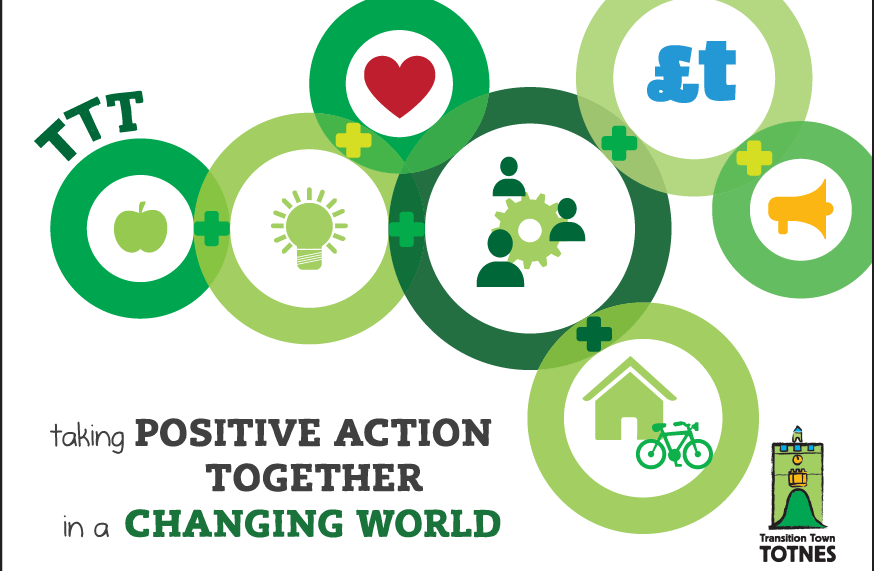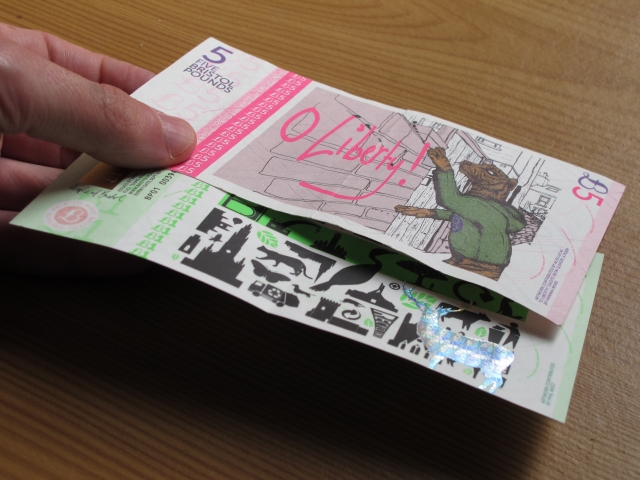
The Transition Network began in 2006 in the small rural UK town of Totnes, Devon. It was initially a response to the twin threats of climate change and peak oil – what happens when global oil production peaks, plateaus and begins a long decline – and grew rapidly to become a global movement.
To begin with the approach was focused on plans for ‘energy descent’ paths. Since then, it’s remit has become broader. But it remains all about communities stepping up to address the big challenges they face by taking action locally. In practice, this often means reclaiming the town’s economy, sparking entrepreneurship, re-imagining work, re-skilling and weaving webs of connection and support that keep resources in the towns and villages where it is created. Some places may focus on the local food, others on generating renewable energy, others rethinking local transport networks. Others might work on all these things and more.
It’s an approach that has spread to over 50 countries across thousands of groups in towns, villages, cities, universities and schools. The Transition culture aspires to being caring, inclusive and focused on supporting each other, both as groups and in the wider community. There is also an aspect of personal transformation, helping people to move from their current life and aspirations to a new set of hopes and behaviours for the future.
‘REconomy’ is the broad term used to cover the range of activities Transition groups undertake to transform their local economy. This includes new enterprises -especially community owned energy companies and food businesses – local currency projects, ‘buy local’ campaigns and other projects that encourage working with local businesses. Many Transition groups also look at infrastructure, including the availability of land, working space and support for entrepreneurs.

They have been early adopters of new business models, encouraging the formation of social enterprises that benefit the wider community. For instance, in the UK a Transition group in Brixton raised £130,000 to install the UK’s first inner-city, community-owned power station, consisting of 82kW of solar panels on top of a council estate. A group in Derbyshire created a food hub that makes it economically viable to grow food in back gardens for sale, as an affordable alternative to supermarkets.

As the network grew, hubs developed as resources centres to help new groups form and organise. Hubs started forming in 2008 (Ireland, Scotland, Italy, Japan, Spain, Sweden) and 2009 (Germany, Australia, Denmark, France). Today there are 34 national and regional hubs, formed to share knowledge, best practice, resources and creative ideas. They are at the heart of a wider movement of networks, organisations and individuals who are creating and telling the story of new economies. Hubs are able to use their voices collectively and over time, they’ve evolved into a collaborative, family-like network with shared values and intentions.
The Transition Network is interesting because it is a positive, empowering movement that has spread organically through word of mouth and communities of practice. Its principles of localism, learning through action, collaboration and building community means that it has translated well across different cultures with sufficient flexibility to respond to very different conditions on the ground. The movement has described itself as a social experiment.
Transition offers people a wide range of reasons to get involved:
The Transition movement describes successful work as finding a balance between the head, heart and hands:
One of the co-founders of the Transition movement was Permaculture educator, Rob Hopkins, who models transition principles by learning from mistakes and sharing the stage with many, including his students at the Kinsale Further Education College in Ireland. In early 2005 they created the Kinsale Energy Descent Action Plan, which was later adopted as policy by the Town Council. It was the first strategic community planning document of its kind, and went beyond the issues of energy supply, to look at across-the-board creative adaptations in the realms of food, farming, education, economy, health, and much more.
After moving back to the UK to complete his doctorate, Rob decided to take the peak oil preparation process beyond the classroom and into the community. This led to the creation of Transition Towns Totnes in early 2006, and it took off. It has since spread virally across the world as groups in other communities quickly copied the model and initiated the transition process in their own locale.
Transition is a movement of ordinary people and communities who are engaged in real time experiments – learning from each other and copying what works. The network is a self organising, even chaotic and certainly creative space that anyone can join at any time. Most of its members are already busy working people, lacking the time and resources to do anything more structured. Yet this way of working has also been the subject of many academic studies, because it has yielded great results – both in terms of projects that innovate like the local currencies of groups in Totnes, Stroud, Lewes, Brixton and Bristol and the social cohesion of groups such as the group in Pittsburgh in the US, where they concentrate on bringing in those previously excluded from the conversation.
Unlike other campaign groups, the Transition network never set out to alarm people, and has remained resolutely upbeat, determined to find opportunity in what most regard with dismay. One of the movement’s most fundamental ideas was to ask what the world might look like in the future “if we get it right” – then work out backwards how to get there. The idea of “visioning” is important in the Transition process, often resulting in a move towards self-sufficiency at the local level, in food, energy and much else. What is important is that whatever “getting it right” might look like, no one is waiting for the answer to be handed down from above. For example, the US L.A. Transition Town branch is now focused on food-growing initiatives – community gardening above all, and lawn renewal, along with alternative medical practitioners they have identified as low-impact. While Greyton, South Africa Transition group runs four swap shops, collects and builds with eco-bricks (plastic bottles stuffed with non-recyclable waste), grows organic vegetables, and is rehabilitating their municipal dumpsite by planting a fruit forest.
The Transition design model offers a straightforward 12-step guide to organising a community toward non-reliance on oil. Ideas are freely shared and can be taken up rapidly, widely and effectively, because each community takes ownership of the process themselves. The focus of localism means that transition looks different in different places but the basic outcome means reductions in the use of fossil fuels and an increase in community cohesion. The accompanying inner transition encourages individuals within the movement to think about what it feels like to make the transition, and how they might find meaning and satisfaction in a life with fewer material goods.
One of the biggest challenges for the Transition movement stems ironically from its greatest strength. People involved are typically highly motivated by local action, less by big remote policy work. But change at the local level is often heavily constrained by the broader economic policy framework. The big question, then, for the future contribution from Transition groups is to identify and win the changes needed to that framework that will allow them to flourish more easily, and help deliver change at the speed and scale needed to turnaround the range of climate, social and ecological crises.
Currently less well known about in the UK – but definitely embedded and growing internationally – is the Municipalities in Transition project and series of pilots. Working to address that next step from local citizen to municipal policy level – these pilots and research are an important piece in the future jigsaw. Particularly in countries where power is being devolved to Mayors.
Flintoff, J-P. 2013. The Guardian. “Local, self-sufficient, optimistic: are Transition Towns the way forward?” https://www.theguardian.com/environment/2013/jun/15/transition-towns-way-forward
Transition US. How did the transition movement start https://www.transitionus.org/faq/how-did-transition-movement-start
Transition Map. https://transitioninitiative.org
Signal, R. 2013. Christian Science Monitor. “Transition Towns moves communities beyond sustainability to resiliency”. https://www.csmonitor.com/World/Making-a-difference/Change-Agent/2012/0424/Transition-Towns-moves-communities-beyond-sustainability-to-resiliency